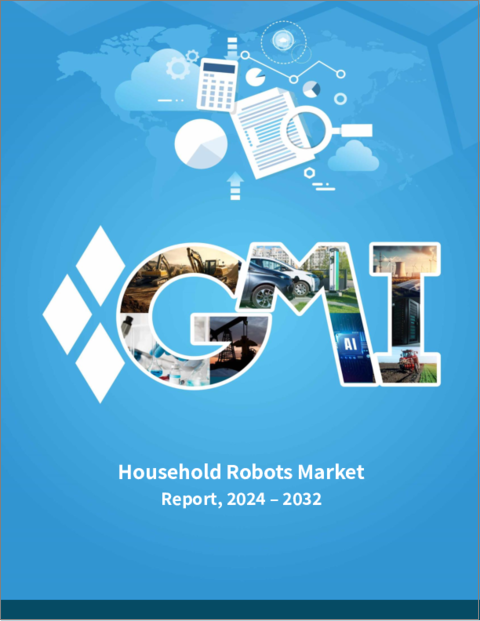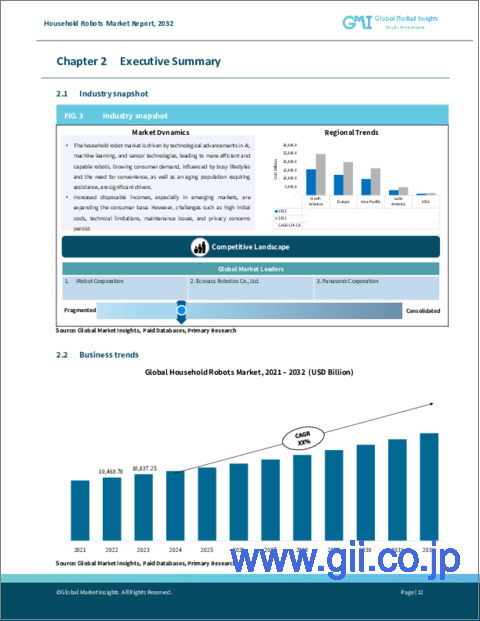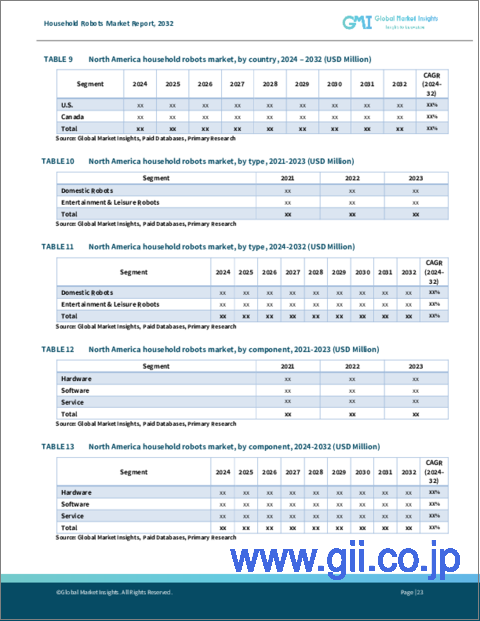|
|
市場調査レポート
商品コード
1472019
家庭用ロボット市場:タイプ別、コンポーネント別、用途別、流通チャネル別、予測、2024~2032年Household Robots Market - By Type, By Component, By Application, By Distribution Channel & Forecast 2024 - 2032 |
||||||
カスタマイズ可能
|
|||||||
| 家庭用ロボット市場:タイプ別、コンポーネント別、用途別、流通チャネル別、予測、2024~2032年 |
|
出版日: 2024年02月29日
発行: Global Market Insights Inc.
ページ情報: 英文 230 Pages
納期: 2~3営業日
|
全表示
- 概要
- 目次
家庭用ロボット市場規模は、技術の進歩と消費者のライフスタイルの変化が融合し、2024年から2032年にかけてCAGR19.3%以上で拡大すると推定されます。
自動化技術が発展し続ける中、家庭用ロボットは、掃除、料理、ホームセキュリティなど、幅広い家事タスクに対応するため、ますます高度化しています。最近では、特に家事の時間が限られている共働き世帯を中心に、消費者の間で利便性と時間節約のソリューションに対する需要が著しく高まっています。
さらに、ロボット掃除機やその他の自動化機器は、エネルギー消費を最適化し、無駄を省くように設計されており、消費者の間でエコを重視する傾向が強まっています。AIとMLの強力な進歩により、家庭用ロボットが学習して個人の好みに適応することも可能になり、その実用性と消費者への訴求力が高まっています。2024年1月、SamsungはAIを使って汚れを検知し、スチームで床を掃除する初のロボット掃除機を発表しました。
家庭用ロボット市場は、タイプ、コンポーネントタイプ、用途、流通チャネル、地域に分類されます。
コンポーネント別では、ロボット機器の機能性と性能により、ハードウェア・セグメントからの業界価値は予測期間中に急速な拡大を遂げると考えられています。センサー、アクチュエーター、プロセッサー、モーターなどの主要ハードウェアコンポーネントは、ナビゲーションや障害物検知から操作やインタラクションに至るまで、様々なタスクを効率的に実行するために不可欠です。技術の進歩によって家庭用ロボットの能力が向上し続けるにつれ、信頼性、精度、耐久性を確保するための高品質なハードウェア部品の需要が高まります。
タイプ別では、エンターテインメント・レジャー分野の家庭用ロボット市場は、消費者の進化するニーズや選好に対応するための採用率が高いことから、2024年から2032年にかけて18%以上の成長率を示すと予測されます。エンターテインメント・レジャーロボットは、双方向ゲーム、音声制御アシスタント、エンターテインメント機能などの革新的な機能を提供し、家庭用ロボットの全体的なユーザー体験と魅力を高めます。消費者が家庭での交友、娯楽、利便性をますます求めるようになり、娯楽・レジャー型ロボットの需要が急増しています。
欧州の家庭用ロボット産業規模は、2024年から2032年にかけてCAGR19%以上を記録する予定です。欧州では高齢化人口が増加しており、高齢者の自立生活や介護支援ニーズに応える支援ロボットの需要が高まっています。さらに、消費者が家庭でのエネルギー効率と利便性のために革新的なソリューションを求めているため、スマートホーム技術と持続可能性に対する文化的傾斜が、この地域の市場成長をさらに加速させています。
目次
第1章 調査手法と調査範囲
第2章 エグゼクティブサマリー
第3章 業界洞察
- 業界のエコシステム分析
- ベンダー・マトリックス
- 利益率分析
- テクノロジーとイノベーションの展望
- 特許分析
- 主要ニュースと取り組み
- 規制状況
- 影響要因
- 促進要因
- 業界の潜在的リスク・課題
- 成長可能性分析
- ポーター分析
- PESTEL分析
第4章 競合情勢
- イントロダクション
- 企業市場シェア分析
- 競合のポジショニング・マトリックス
- 戦略展望マトリックス
第5章 市場推計・予測:タイプ別、2018年~2032年
- 主要動向
- 家庭用ロボット
- エンターテインメント・レジャーロボット
第6章 市場推計・予測:コンポーネントタイプ別、2018年~2032年
- 主要動向
- ハードウェア
- ソフトウェア
- サービス
- サポート・メンテナンス
- ソフトウェア・サブスクリプション
- データ分析
第7章 市場推計・予測:用途別、2018年~2032年
- 主要動向
- 掃除機・モップ掛け
- 芝刈り
- プール清掃
- 交友
- その他
第8章 市場推計・予測:流通チャネル別、2018年~2032年
- 主要動向
- オンライン販売
- 小売店
- ホームセンター
- 家電量販店
第9章 市場推計・予測:地域別、2018年~2032年
- 主要動向
- 北米
- 米国
- カナダ
- 欧州
- 英国
- ドイツ
- フランス
- イタリア
- スペイン
- ロシア
- その他欧州
- アジア太平洋
- 中国
- インド
- 日本
- 韓国
- ニュージーランド
- その他アジア太平洋
- ラテンアメリカ
- ブラジル
- メキシコ
- その他ラテンアメリカ
- 中東・アフリカ
- UAE
- サウジアラビア
- 南アフリカ
- その他の中東・アフリカ
第10章 企業プロファイル
- Blue Frog Robotics
- Dolphin Robotics
- Ecovacs Robotics Co., Ltd.
- Honda Motor Co., Ltd.
- Husqvarna Group
- iRobot Corporation
- Jibo
- LG Electronics Inc.
- Maytronics Ltd.
- Neato Robotics Inc.
- Robomow
- SoftBank Robotics
Household Robots Market size is estimated to expand at over 19.3% CAGR from 2024 to 2032, driven by the convergence of technological advancements and changing consumer lifestyles. As automation technologies continue to develop, household robots are becoming increasingly sophisticated for catering to a wide range of domestic tasks, such as cleaning, cooking, and home security. Of late, the demand for convenience and time-saving solutions among consumers, particularly in dual-income households where time for household chores is limited, is significantly rising.
Moreover, robot vacuum cleaners and other automated devices are designed to optimize energy consumption and reduce waste, aligning with the growing emphasis on eco-friendly practices among consumers. Strong advancements in AI & ML also enable household robots to learn and adapt to individual preferences, enhancing their utility and appeal to consumers. In January 2024, Samsung unveiled its first robot vacuum-mop that used AI to detect stains and could steam clean floors.
The household robots market is classified into type, component type, application, distribution channel, and region.
Based on component, the industry value from the hardware segment will witness rapid expansion in the forecast period, owing to the functionality and performance of robotic devices. Key hardware components, such as sensors, actuators, processors, and motors are essential for executing various tasks efficiently, ranging from navigation and obstacle detection to manipulation and interaction. As technological advancements continue to enhance the capabilities of household robots, the demand for high-quality hardware components to ensure reliability, accuracy, and durability will rise.
In terms of type, the household robots market from the entertainment & leisure segment is projected to depict over 18% growth rate from 2024 to 2032, due to the higher adoption for catering to the evolving needs and preferences of consumers. Entertainment & leisure robots offer innovative features, such as interactive games, voice-controlled assistants, and entertainment functionalities for enhancing the overall user experience and appeal of household robots. As consumers increasingly seek companionship, entertainment, and convenience in their homes, the demand for entertainment and leisure type robots is surging.
Europe household robots industry size is slated to record over 19% CAGR during 2024-2032, attributed to the stringent regulations and standards regarding labor and safety. The increasing aging population in Europe is fueling the demand for assistive robots for catering to the needs of elderly individuals for independent living and caregiving support. Moreover, the cultural inclination towards smart home technologies and sustainability is further accelerating the regional market growth, as consumers seek innovative solutions for energy efficiency and convenience in their households.
Table of Contents
Chapter 1 Methodology & Scope
- 1.1 Market scope & definitions
- 1.2 Base estimates & calculations
- 1.3 Forecast calculations
- 1.4 Data sources
- 1.4.1 Primary
- 1.4.2 Secondary
- 1.4.2.1 Paid sources
- 1.4.2.2 Public sources
Chapter 2 Executive Summary
- 2.1 Industry 360 degree synopsis, 2018 - 2032
Chapter 3 Industry Insights
- 3.1 Industry ecosystem analysis
- 3.2 Vendor matrix
- 3.3 Profit margin analysis
- 3.4 Technology & innovation landscape
- 3.5 Patent analysis
- 3.6 Key news and initiatives
- 3.7 Regulatory landscape
- 3.8 Impact forces
- 3.8.1 Growth drivers
- 3.8.1.1 Increasing demand for automation and convenience
- 3.8.1.2 Integration of smart home ecosystems
- 3.8.1.3 Rising technological advancements
- 3.8.1.4 Growing aging population seeking home assistance
- 3.8.1.5 Growing focus on environmental consciousness
- 3.8.2 Industry pitfalls & challenges
- 3.8.2.1 Limited adaptability
- 3.8.2.2 Privacy infringement concerns
- 3.8.1 Growth drivers
- 3.9 Growth potential analysis
- 3.10 Porter's analysis
- 3.10.1 Supplier power
- 3.10.2 Buyer power
- 3.10.3 Threat of new entrants
- 3.10.4 Threat of substitutes
- 3.10.5 Industry rivalry
- 3.11 PESTEL analysis
Chapter 4 Competitive Landscape, 2023
- 4.1 Introduction
- 4.2 Company market share analysis
- 4.3 Competitive positioning matrix
- 4.4 Strategic outlook matrix
Chapter 5 Market Estimates & Forecast, By Type, 2018 - 2032 (USD Million)
- 5.1 Key trends
- 5.2 Domestic robots
- 5.3 Entertainment & leisure robots
Chapter 6 Market Estimates & Forecast, By Component Type, 2018 - 2032 (USD Million)
- 6.1 Key trends
- 6.2 Hardware
- 6.3 Software
- 6.4 Service
- 6.4.1 Support and maintenance
- 6.4.2 Software subscriptions
- 6.4.3 Data analytics
Chapter 7 Market Estimates & Forecast, By Application, 2018 - 2032 (USD Million)
- 7.1 Key trends
- 7.2 Vacuuming & mopping
- 7.3 Lawn mowing
- 7.4 Pool cleaning
- 7.5 Companionship
- 7.6 Others
Chapter 8 Market Estimates & Forecast, By Distribution Channel, 2018 - 2032 (USD Million)
- 8.1 Key trends
- 8.2 Online sales
- 8.3 Retail stores
- 8.4 Home improvement stores
- 8.5 Appliance stores
Chapter 9 Market Estimates & Forecast, By Region, 2018 - 2032 (USD Million)
- 9.1 Key trends
- 9.2 North America
- 9.2.1 U.S.
- 9.2.2 Canada
- 9.3 Europe
- 9.3.1 UK
- 9.3.2 Germany
- 9.3.3 France
- 9.3.4 Italy
- 9.3.5 Spain
- 9.3.6 Russia
- 9.3.7 Rest of Europe
- 9.4 Asia Pacific
- 9.4.1 China
- 9.4.2 India
- 9.4.3 Japan
- 9.4.4 South Korea
- 9.4.5 ANZ
- 9.4.6 Rest of Asia Pacific
- 9.5 Latin America
- 9.5.1 Brazil
- 9.5.2 Mexico
- 9.5.3 Rest of Latin America
- 9.6 MEA
- 9.6.1 UAE
- 9.6.2 Saudi Arabia
- 9.6.3 South Africa
- 9.6.4 Rest of MEA
Chapter 10 Company Profiles
- 10.1 Blue Frog Robotics
- 10.2 Dolphin Robotics
- 10.3 Ecovacs Robotics Co., Ltd.
- 10.4 Honda Motor Co., Ltd.
- 10.5 Husqvarna Group
- 10.6 iRobot Corporation
- 10.7 Jibo
- 10.8 LG Electronics Inc.
- 10.9 Maytronics Ltd.
- 10.10 Neato Robotics Inc.
- 10.11 Robomow
- 10.12 SoftBank Robotics





